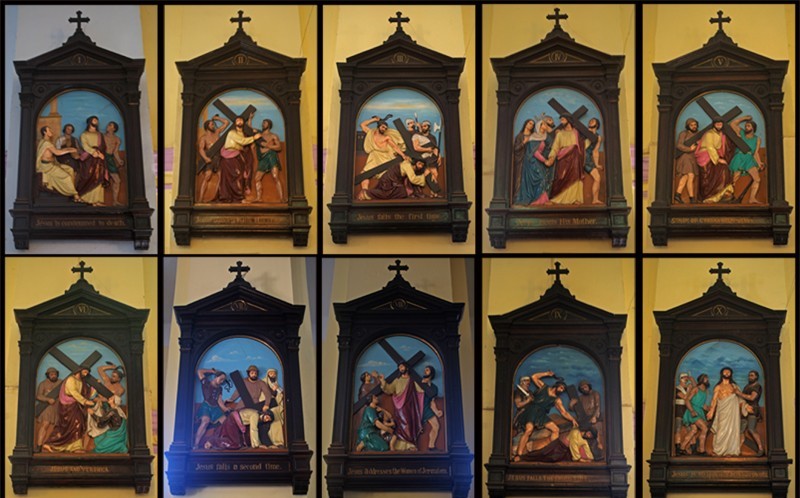The Stations of the Cross
National Liturgical Council

In most, if not all, Catholic churches, a series of crosses or artistic images are displayed around the walls representing the journey of Christ on Good Friday along the Via Dolorosa to his crucifixion at Calvary.
The Stations of the Cross is not a required prayer nor a liturgical service, but a devotional practice that focuses on the sufferings of Christ, particularly during Lent as we anticipate the celebration of Christ’s passion during Holy Week.
A Pilgrimage
The object of the Stations is to help us to make in spirit, as it were, a pilgrimage to the holy places at Jerusalem, and this has become one of the most popular of Catholic devotions. It is carried out by passing from Station to Station, with certain prayers and devout meditation on the various incidents in turn; either individually, or communally led by a parish lay leader, priest or deacon.
Traditional Stations
The Traditional Stations begin with Pilate’s condemnation of Christ and conclude with Jesus being laid in the tomb. During the second half of the last century, many added a fifteenth station, the Resurrection of Jesus, although there was no artistic representation of this scene.
- Jesus is condemned to death
- Jesus takes up his Cross
- Jesus falls the first time
- Jesus meets his Mother
- Simon of Cyrene helps Jesus carry the Cross
- Veronica wipes the face of Jesus
- Jesus falls for the second time
- Jesus meets the women of Jerusalem
- Jesus falls for the third time
- Jesus is stripped of his garments (sometimes called the "Division of Robes")
- Jesus is nailed to the Cross
- Jesus dies on the Cross
- Jesus is taken down from the Cross
- Jesus is laid in the tomb
Scriptural Stations
On Good Friday, 1991 Pope John Paul II led a crowd of people at the Roman Colosseum through the Stations of the Cross as was traditional. However, he changed the format, altering the fourteen stations and adding a fifteenth. They are often referred to as Scriptural Stations as each station has the Gospel as its basis.
- Jesus prays in the Garden of Gethsemane;
- Jesus is betrayed by Judas and arrested;
- Jesus is condemned by the Sanhedrin;
- Jesus is denied by Peter three times;
- Jesus is judged by Pilate;
- Jesus is scourged and crowned with thorns;
- Jesus takes up his cross;
- Jesus is helped by Simon of Cyrene to carry his cross;
- Jesus meets the women of Jerusalem;
- Jesus is crucified;
- Jesus promises his kingdom to the repentant thief;
- Jesus entrusts Mary and John to each other;
- Jesus dies on the cross; and
- Jesus is laid in the tomb.
Journey of Life
To "make the Stations of the Cross" is to acknowledge that life is a journey. It is also to acknowledge that life does not end with death as the Cross was not the end.
The crucifix and Stations of the Cross, point to something beyond what is represented. They fundamentally lead people to ponder the enormous love of Jesus Christ for them, a love visible by his suffering and death endured so that all might be forgiven their sins and freed from guilt.
This article was originally published in ‘Prayer and Devotions’. © Diocese of Parramatta. 2007. Reprinted with permission.
Image Attribution - Collage of Christ's 14 cross station, Portuguese Church, Kolkata, Rangan Datta
